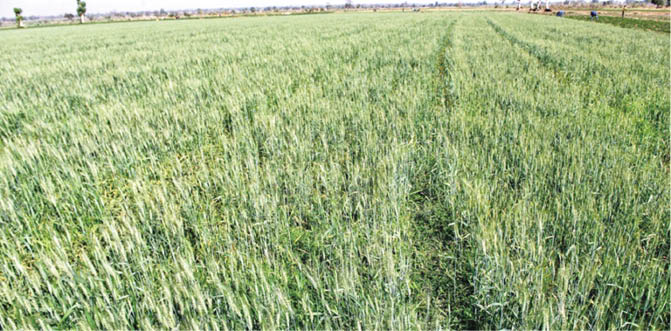Since the nation is in a drive for import substitution, producing wheat locally will result in forex savings which would otherwise be channelled to other more productive related priorities of the economy.
Seeding Rates
The optimum plant population for wheat is 220-250 plants per m2. Seed rate depends on the seed size, germination percentage, planting conditions and planting method. To achieve optimum population density, a seeding rate of about 110-125 kg/ha when drilling and 125-135 kg/ha when broadcasting with a vicon spreader is recommended. To ensure good crop standability and yield, farmers should adhere to these optimum population densities. Diseases such as Powdery mildew are also minimized with good agronomic practices.
Irrigation requirements and scheduling
Since there is very little or no rainfall during winter in Zimbabwe, irrigation is required to achieve a high yielding wheat crop. The total gross amount of water required is between 450 and 600 mm per ha (i.e. 4.5 – 6 mega litres per ha) depending on method of irrigation (Overhead irrigation with sprinkler or use of Centre Pivots) and must be applied as the crop requires it. The key points are:
7 years after, Benue farmers seek improved agric budget
Prune Nourry immortalises missing Chibok Girls with ‘Statues Also Breathe’
the soil must be brought to field capacity to the full potential rooting depth (about 1,2 m) at planting to emerge the crop;
a light irrigation must be applied at the 4th or 5th day after sowing, to break the crust to ensure good crop emergence
a light irrigation must be applied at 14 to 17 days after emergence to stimulate crown root development and tillering, and;
irrigation thereafter must be applied to match crop water use. On sandy soils with low water holding capacities, irrigate frequently (7-to-9-day cycles with 30-35mm net). On clays and sandy clays, with good water holding capacities, irrigation may be less frequent with larger amounts (10-to-14-day cycles with 40–45 mm net). This is a general irrigation scheduling guide. For an informed irrigation scheduling, the use of a soil auger to evaluate the soil water content ahead and behind the irrigation line is a good aid to irrigation management. Irrigation is terminated when the neck of the ears/spikes/head (peduncle) turn yellow i.e. physiological maturity.
Crop hardening: After the crop has emerged, the hardening stage begins. This induces crown root development as well as tillering. The recommended hardening period (irrigation is temporarily terminated during this stage) is 10 and 14 days in light and heavy soils respectively.
Top dressing fertilizer and herbicide application is done after a light irrigation which follows the hardening period, normally about 21 days after emergence.
Fertilisation
The fertiliser regime management in wheat, like any other crop must be tailored to the soil fertility status, the yield potential and the grain quality requirements. As a general guide, wheat requires a basal application of 300 to 500 kg/ha of a compound fertiliser (such as 7–14–7) and a top dressing of 350 to 500 kg of Urea or Ammonium Nitrate per ha. Both fertilizer dressings are broadcast by a vicon.
Generally, 160–190kg/ha of Nitrogen Units (N), 50–70 units of Phosphorous (P) and 30–50 units of Potassium (K) are adequate for optimum plant growth. Basal fertilizer need incorporation into the soil by discing and should be applied after primary tillage. The top dressing is usually applied in one application between 14–21 days after emergence on heavy soils, and in two applications of equal amounts at 14 and 35 days after emergence on sandy soils. Top dressing should be applied after the hardening stage. Top dressing is essential for good leaf and general plant growth and ultimately the yield but also importantly for attaining good protein levels. The minimum protein level requirement for “Premium” (Good quality) wheat is 11%. It is one of the considerations for grading and pricing of wheat. Attainment of good protein levels is also determined by varietal choice and general management. Application of Nitrogen after flowering can also boost the Grain Protein Content of wheat.
All fertility management practices must be based on proper full soil analysis recommendations by approved laboratories.
Weed control
Farmers are advised to use some wheat specific post-emergence herbicide which should be applied after a light irrigation which follows the hardening period (2 weeks after crop emergence). We also recommend farmers to apply specific herbicides against volunteer crops.
Farmers can consult agronomists and agrochemical companies for herbicide recommendations and it is important for farmers to read labels whenever they are applying herbicides.
Pests and diseases.
Aphids and stalk borers can attack wheat with aphids coming in earlier soon after tillering while borers can attack the plant from flowering onwards. Farmers must also be on the look-out for “Fall armyworm” given that wheat is one of the host crops to the pest. These pests can be controlled with appropriate pesticide sprays after scouting.
Diseases such as Leaf rust, Stem rust, Powdery mildew, Fusarium head blight and Take-all may cause yield reduction. Farmers must seek professional advice on how to control these diseases. The best bet is for farmers to grow resistant varieties and Seed Co wheat varieties such as SC Select are resistant to these diseases. Generally, two preventative fungicide sprays are recommended if farmers are located in disease prone areas and gives some form of insurance against climate change that can result in new disease pathotypes.
NB: Farmers are encouraged to scout their wheat crop for diseases, pests and deficiencies and make spraying decisions early when pest/disease reaches economic threshold levels.
SOURCE: Seed Co Limited

 Join Daily Trust WhatsApp Community For Quick Access To News and Happenings Around You.
Join Daily Trust WhatsApp Community For Quick Access To News and Happenings Around You.


